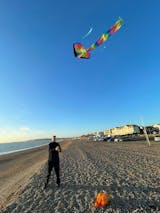Excited to learn the art of flying a kite? I'll guide you through the basics in this beginner's guide. Imagine the thrill of watching your kite soar high in the sky, dancing with the wind. It's a timeless activity that brings joy and excitement to people of all ages.
From choosing the right kite to mastering the techniques, I'll walk you through each step to ensure a successful flight. Whether you're a young enthusiast or a seasoned adult looking to relive childhood memories, flying a kite is a fantastic way to unwind and connect with nature.
Ready to embark on this adventure? Let's dive into the world of kite flying and make memories that will last a lifetime.
Choosing the Right Kite
When I first started flying kites, choosing the right one was crucial for a successful and enjoyable experience. Let me guide you through selecting the perfect kite for your adventure.
Types of Kites
- Diamond Kites: These are classic diamond-shaped kites that are easy to assemble and great for beginners.
- Parafoil Kites: Made of soft, lightweight materials, these kites are simple to launch and ideal for kids and beginners.
- Delta Kites: Known for their stability and ease of control, delta kites are perfect for windy days and more advanced flyers.
Essential Factors
- Skill Level: Consider your expertise – beginners should opt for easy-to-control kites like diamond or parafoil kites.
- Wind Conditions: Choose a kite that suits the wind conditions of your flying location to ensure a successful flight.
- Purpose: If you're flying with children, consider kites designed for kids for a fun and safe experience.
By understanding the different types of kites available and considering essential factors, you can confidently choose the right kite for your next soaring adventure.
Preparing to Fly
When I prepare to fly a kite, I make sure I have all the necessary materials ready and set up my kite correctly for a successful flight.
Materials Needed
- For flying a kite, I must have the kite itself, a spool of kite string, and a suitable flying location with open space.
- Ensure that the kite you choose matches your skill level; for beginners, a diamond-shaped kite would be ideal.
- Kids can enjoy flying kites designed specifically for children, which are often lightweight and easy to handle.
- You can find a variety of kites for sale online or in stores, catering to different preferences and age groups.
- Find a clear area with open space away from trees, buildings, and power lines.
- Lay out all the kite components – the kite, string, and handles – on the ground.
- Assemble the kite according to the manufacturer's instructions, making sure all parts are secure.
- Attach the kite string to the bridle of the kite, ensuring a strong connection for stable flight.
- Hold the kite up and let the wind catch it to launch it into the sky smoothly.
- Once the kite is airborne, release more string gradually to achieve greater heights and enjoy the mesmerizing flight.
Safety Tips Before Taking Off
When flying a kite, safety should always come first. Follow these essential safety tips to ensure a fun and worry-free kite-flying experience:
- Check the Weather: Before heading out, I make sure to check the weather forecast. Kite flying is best enjoyed on windy days with clear skies. Avoid flying a kite near power lines during stormy weather.
- Choose the Right Location: I always select an open area away from trees, buildings, and busy roads. Open parks or beaches are ideal spots for flying kites safely, allowing them to catch the wind without any obstructions.
- Inspect the Equipment: Before take-off, I carefully inspect my kite and equipment. I ensure that the strings are untangled, the kite frame is sturdy, and there are no tears or damages that could affect its flight.
- Maintain a Safe Distance: When the kite is in the air, I maintain a safe distance from other kite flyers to avoid entangled lines or collisions. Keeping a distance also provides ample space for the kite to soar freely.
- Avoid Overhead Power Lines: I stay clear of overhead power lines when flying a kite. These lines pose a significant safety risk, and it's crucial to maintain a safe distance to prevent accidents.
By following these safety tips, I can enjoy a thrilling kite-flying experience while ensuring the well-being of myself and others around me.
Flying Your Kite
When flying your kite, it's essential to consider various aspects to ensure a successful and enjoyable experience. From finding the right location to mastering techniques for launching and managing the kite in the air, each step contributes to a memorable kite-flying adventure.
Finding the Right Location
- Identify Open Spaces: Seek out wide, open areas away from trees and buildings to avoid obstacles that could hinder your kite's flight.
- Check Wind Conditions: Select a location with steady wind flow, ideally a beach or a field, to ensure optimal conditions for flying your kite smoothly.
Techniques for Launching a Kite
- Hold the Spool Firmly: Grasp the spool with a firm grip to control the release of the kite and prevent it from flying away uncontrollably.
- Run Against the Wind: Start running gently against the wind while releasing the kite, allowing it to catch the wind and lift off gracefully into the sky.
- Maintain Tension on the String: Keep a steady tension on the string to control the kite's direction and altitude, preventing it from spiralling or losing stability.
- Adjust in Gusts: Be prepared to adjust the string length as needed when the wind gusts, ensuring the kite remains stable and doesn't lose height unexpectedly.
By adhering to these guidelines and mastering the art of kite flying techniques, you can elevate your kite-flying experience and create lasting memories in the sky.
Common Issues and Troubleshooting
When faced with common issues while flying kites, it is essential to troubleshoot effectively to get back to enjoying the experience.
Kite Won't Take Off
If your kite is refusing to take off, ensure that you have enough wind to lift the kite. Check if you are in an open area with sufficient airflow. Additionally, verify that the kite string is attached properly and that there are no tangles hindering the launch.
Kite Keeps Crashing
If your kite keeps crashing back down, assess the wind conditions to determine if they are too strong or too weak for the specific type of kite you are flying. Adjust the angle of the kite to catch the wind properly and ensure a stable flight trajectory.
Dealing With Tangles
Tangles in your kite string can be frustrating, but take your time to unravel them carefully to avoid damaging the string or the kite. Hold the spool firmly while untangling to prevent the kite from getting further entangled.
By addressing these common issues and applying troubleshooting techniques effectively, you can overcome challenges while flying your kite and make the most of your outdoor adventure.
Additional Tips for Beginners
When flying a kite, it is crucial to consider the weather conditions and learn from common mistakes for a successful and enjoyable experience. Here are a few additional tips that can help beginners make the most of their kite flying adventure:
Best Weather Conditions for Flying Kites
- Optimal Wind Speed: For beginners, it is best to fly kites in light to moderate winds, typically around 5-15 kilometers per hour. This wind range provides enough lift for the kite without making it difficult to control.
- Stable Wind Direction: Look for locations where the wind blows consistently in one direction. Avoid flying in areas with swirling or turbulent wind patterns, as they can make it challenging to keep the kite in the air.
- Open Areas: Choose spacious open areas such as parks, beaches, or fields with minimal obstacles like trees and buildings. These locations provide ample space to launch and fly the kite without the risk of it getting caught on obstacles.
- Launching Technique: One common mistake beginners make is pulling too hard when launching the kite. Instead, gently release the line as the wind catches the kite to allow it to ascend smoothly.
- Tangle Prevention: To avoid tangles, ensure the lines are straight before launching the kite. Untangle any knots or twists in the string before sending the kite skyward to prevent mid-air tangles that may lead to crashes.
- Patience and Practice: Remember that flying a kite takes practice. Don't get discouraged by initial failures. Keep practicing launching and controlling the kite, and soon you will master the art of flying it smoothly.
By following these additional tips and being mindful of the weather conditions while learning from common mistakes, beginners can enhance their kite flying skills and enjoy a fulfilling outdoor activity.
Key Takeaways
- Choosing the right kite is crucial for a successful experience, considering factors like skill level, wind conditions and purpose.
- Prepare for flying by ensuring you have all necessary materials, selecting a clear open space and assembling the kite correctly.
- Prioritize safety by checking weather conditions, choosing a safe location, inspecting equipment, maintaining a safe distance and avoiding overhead power lines.
- The success of flying your kite relies on finding the right location with open spaces and suitable wind conditions, mastering launching techniques and maintaining tension on the string.
- Troubleshoot common issues like the kite not taking off, crashing or tangles effectively to enjoy a smooth kite-flying experience.
- Additional tips for beginners include flying in optimal wind conditions, choosing open areas, using a gentle launching technique, preventing tangles and practicing patience to master the art of flying a kite.
Conclusion
Flying a kite is a delightful activity that connects us with nature and brings joy to people of all ages. Remember to choose the right kite for your skill level and purpose, whether you're a beginner, a kid, or an advanced flyer. Safety is paramount, so always check weather conditions and maintain a safe distance from others. Finding the perfect location with steady wind flow is key to a successful flight. Practice launching techniques and be patient when troubleshooting any issues that may arise. By following these tips and embracing the experience with enthusiasm, you'll soon be soaring high in the sky with your kite. Enjoy the simple pleasure of kite flying and let the wind carry your spirits to new heights.
Frequently Asked Questions
Q: What kite is recommended for beginners?
A: For beginners, a diamond kite is recommended due to its simplicity and ease of control.
Q: What kite is suitable for kids?
A: Parafoil kites are great for kids due to their simple design and easy assembly.
Q: What kite is best for advanced flyers?
A: Advanced flyers would enjoy flying delta kites for their agility and high performance.
Q: How can I stay safe while flying a kite?
A: To stay safe, always check weather conditions, maintain a safe distance from others, and avoid flying near power lines.
Q: What are important aspects to consider when flying a kite?
A: Find a location with steady wind flow, practice proper launching techniques, and be prepared to troubleshoot common issues.
Q: What additional tips are provided for beginners?
A: Beginners should choose optimal weather conditions, focus on tangle prevention, and practice patience and consistency to enhance their kite-flying skills.







